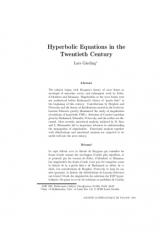Hyperbolic Equations in the Twentieth Century
Hyperbolic Equations in the Twentieth Century
Séminaires et Congrès | 1998

- Consulter un extrait
- Année : 1998
- Tome : 3
- Format : Papier
- Langue de l'ouvrage :
Anglais - Class. Math. : 01A60, 35-03, 46-03
- Pages : 37-68
Le sujet débute avec la théorie de Huygens qui considère les fronts d'onde comme des enveloppes d'ondes plus régulières, et se poursuit par les travaux de Euler, d'Alembert et Riemann. Les singularités des fronts d'onde n'ont pas été comprises avant la théorie de la « partie finie »de Hadamard au début de ce siècle. Les contributions de Herglotz, Petrovsky et dans les années quarante, la théorie des distributions de Laurent Schwartz ont éclairé l'étude des singularités des solutions des EDP hyperboliques. On passe en revue les solutions au problème de Cauchy données par Hadamard, Schauder, Petrovsky et l'auteur. Plus récemment, l'analyse microlocale de M. Sato et L. Hörmander a permis de grandes avancées dans la compréhension de la propagation des singularités. L'analyse fonctionnelle, les distributions et l'analyse microlocale seront certainement des outils importants du prochain siècle.
53C20, 31C12, 60J50

